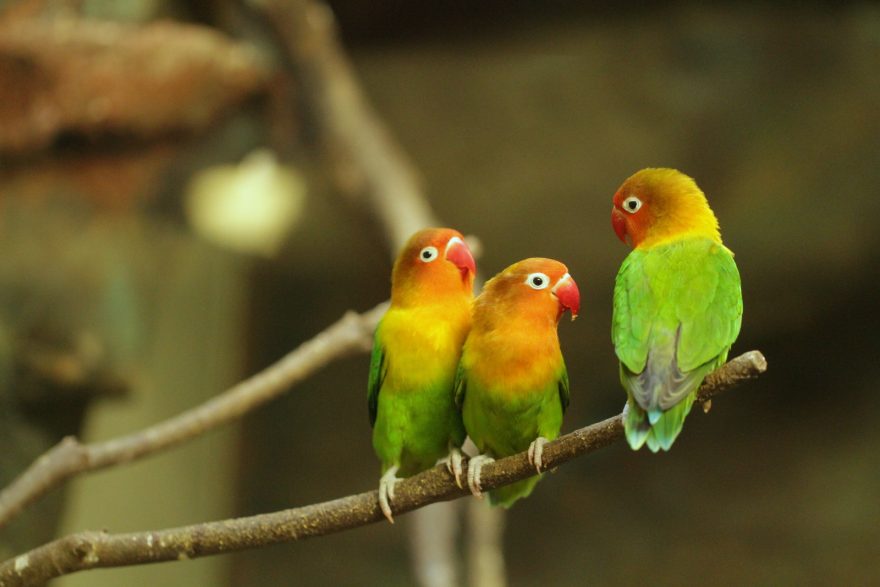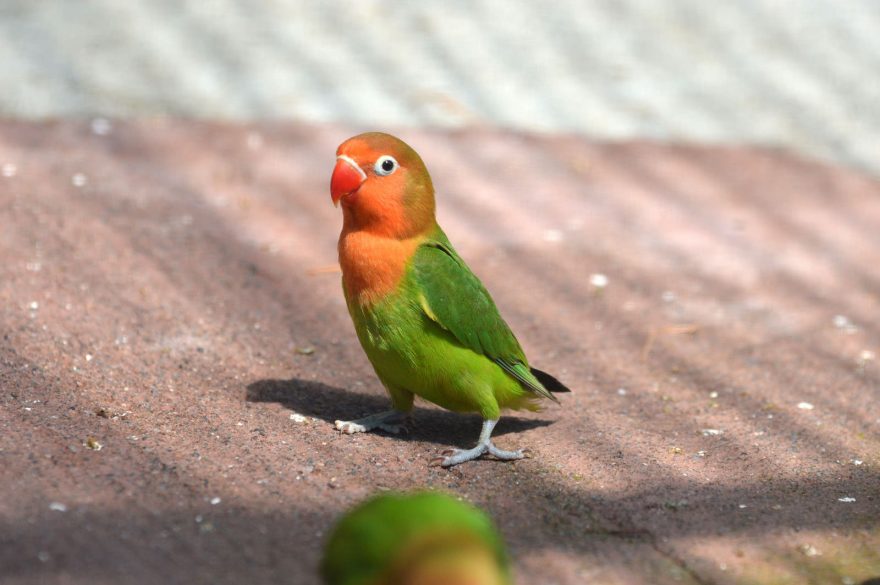The Fischer’s Lovebird is a small parrot native to northern Tanzania. They live in small flocks in high altitude areas among small clumps of trees. In years of drought, they readily travel to Rwanda and Burundi in search of food.
They were first bred in captivity in 1926 and have since become immensely popular in aviaries and as pets. They are known for their charming and affectionate behaviour and complex social needs.

Diet
A quality small parrot seed mix forms the basis of the Fischer’s Lovebird diet. A good diet includes a wide variety of fruit and vegetables; such as apple, pear and corn. Leafy greens are essential; with bok choy, kale and endive the most favoured and nutritious.
Many breeders prefer to feed pellets instead of seed. Pellets provide a more balanced intake of vitamins and minerals and produce less waste. Commercial supplements such as egg & biscuit mix can be added to the diet to provide additional protein during the breeding season.
Housing & Compatibility
Lovebirds can be kept in a wide variety of different aviary types, including cages, traditional aviaries and suspended flights. An adequate amount of flying space is necessary to ensure good fitness and reduce stress. Fischer’s Lovebirds can be quite aggressive, so multiple perches should be placed to allow them to escape one another. These perches should be placed as far apart as possible to increase the amount of exercise they receive.
Non-toxic leaves and branches should be provided for chewing. They will be destructive to foliage in a planted aviary.
Lovebirds make an enormous amount of mess, making concrete the best flooring option. The floor should be loosely littered with nesting material (straw, hay, dried grass) and pieces of cuttlefish bone. The ground will need to be swept roughly once a month to remove discarded seeds and pieces of tree the birds have shredded.
Nest boxes should be placed at a high point in the aviary (to resist invasion from mice, snakes and other pests), preferably all at the same level to prevent territorial disputes. Commercial or home-made nest boxes are suitable. Lovebirds prefer boxes that are slightly larger than a budgie nestbox. Birds will roost in the nest box at night.
Due to their aggressive nature, lovebirds should not be housed with other species of birds. It is not uncommon for weaker birds to be killed during territorial fights between lovebirds – especially during the breeding season.

Breeding
Fischer’s Lovebirds construct a nest from leaves, palm fronds and straw. Some birds will simply pile all of the nesting material into the bottom of a box and lay eggs on the top, while others will construct elaborate tunnels and chambers. Palm fronds increase the humidity of the nest and improve egg hatch rates.
Lovebirds will begin mating with a suitable partner at roughly one year of age. The hen will lay 3-5 eggs approximately one week after mating, which will then be incubated for approximately three weeks. Once the young hatch, both parents will feed the chicks in the nest for approximately a month. Young birds become independent six to eight weeks later.
Sexing
Male and female Fischer’s lovebirds have identical plumage, making visual sexing almost impossible. DNA sexing is the most reliable way to accurately determine a bird’s sex.
A popular way to determine a bird’s sex is by feeling the distance between the pelvis bones. In males, the distance is typically 1–3 mm while measuring 6–8 mm in sexually mature females.
The observation of subtle behavioral differences can also be used to determine a lovebird’s sex. Females are often more aggressive and loud than males. They are also more likely to begin construction of a nest, or construct a nest while not part of an established pair.
Mutations
There are dozens of Fischer’s lovebird color mutation available in aviculture. An uncommon mutation will demand a much higher price than one that’s more readily available. Similarly, the proliferation of mutation birds has significantly increased the rarity and cost of “pure normal” birds.
Fischer’s lovebirds will hybridize with other lovebird species within Agapornis genus. Hybrids are usually infertile and can suffer from a variety of health ailments. Always make sure that an oddly colored bird is actually a mutation and not the product of crossing different species.
As Pets
Hand raised Fischer’s lovebirds make excellent pets. They can be kept as an individual bird or as a pair, however birds kept with a partner will be more attached to each other than to their owner.
Males are generally considered to make superior pets on the basis of their gentler temperament and quieter nature. Regardless of gender, a pet lovebird will require daily interaction and should not be confined to a cage for an extended period of time.
Health
A strict worming and parasite control regime is essential to maintain the long-term health of all captive birds.
A healthy Fischer’s lovebird has a life expectancy of fifteen to twenty years.
I live in Ontario and it is very hard to find Fischer breeder in our area , I could use some ideas !